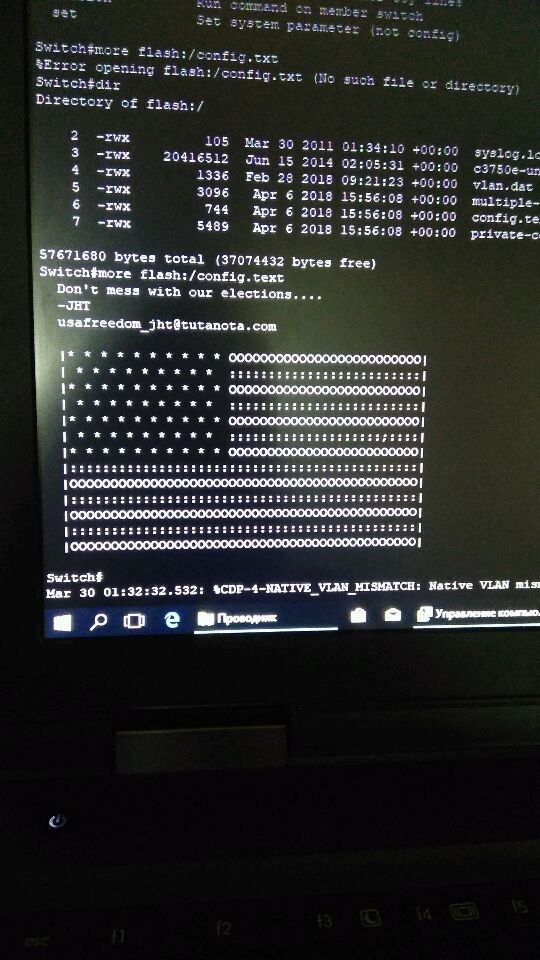Attackers target vulnerability in Cisco switches
'Nation-state' actors leave political messages on 168,000 unpatched IoT devices


Attackers are exploiting a vulnerability in Cisco switches deployed in data centres across the world to leave politically-motivated messages, according to researchers.
Although the scale of the attack has yet to be determined, Talos, Cisco's cybersecurity arm, has identified more than 168,000 IoT devices with the vulnerability, with analysis by Kaspersky Lab suggesting the attack is mostly targeting the Russian-speaking portion of the internet, impacting entire internet providers and data centres.
A bot is searching for vulnerable Cisco switches via the Internet of Things (IoT) search engine Shodan, according to Kaspersky, and once it finds a vulnerability, can exploit the Cisco Smart Install Client software.
The flaw allows attackers to run arbitrary code on the vulnerable switches, before they are able to rewrite the Cisco IOS image and change the configuration file. Devices then boot up with the message "don't mess with our elections" and an image of the United States flag, before the switch becomes unavailable.

Image credit: Kaspersky
Cisco Talos threat researcher Nick Biasini warned that network administrators need to be especially vigilant, suggesting the simplest way to mitigate these issues is to run the command novstack on the affected device.
He said: "It can be easy to 'set and forget' these devices, as they are typically highly stable and rarely changed. Combine this with the advantages that an attacker has when controlling a network device, and routers and switches become very tempting targets."
Sign up today and you will receive a free copy of our Future Focus 2025 report - the leading guidance on AI, cybersecurity and other IT challenges as per 700+ senior executives
Cisco has strongly recommended all customers review their architecture, and use tools provided by Talos to scan their network and remove Cisco Smart Install Client from all devices in instances where it's not being used.
While Talos believes attackers are "associated with nation-state actors", screenshots posted on Twitter by one affected user indicates a group named 'JHT' has claimed responsibility.
Reuters, meanwhile, reported a statement from the Iranian Communication and Information Technology Ministry that says the attack has affected 3,500 switches in Iran.
The Smart Client vulnerability dates back to February of last year, where Cisco first became aware of a significant increase in scans attempting to detect devices where the Smart Install feature remained enabled and without proper security controls, after setup was completed.
Smart Install was initially designed to make life easier for system administrators by allowing remote configuration and OS image management on Cisco switches. By design, these do not require authentication.
Kaspersky Labs suggests it may be a problem of data centres that fail to limit access to the TCP 4786 port, which needs to be open for the Smart Install to work, or to disable Smart Install once it is no longer in use.
Picture credit: Bigstock

Keumars Afifi-Sabet is a writer and editor that specialises in public sector, cyber security, and cloud computing. He first joined ITPro as a staff writer in April 2018 and eventually became its Features Editor. Although a regular contributor to other tech sites in the past, these days you will find Keumars on LiveScience, where he runs its Technology section.
-
 2025 marked the beginning of the end for OpenAI
2025 marked the beginning of the end for OpenAIOpinion OpenAI has its fingers in too many pies and it’s rapidly losing favor with consumers and enterprises alike
-
 Will 2026 be another challenging year for technology?
Will 2026 be another challenging year for technology?Feature SMBs will be looking at how they can prepare for the challenges ahead, from global regulations to AI implementation to digital IDs…
-
 Majority of English data centers use less water than a 'typical leisure center' as operators embrace new cooling methods
Majority of English data centers use less water than a 'typical leisure center' as operators embrace new cooling methodsNews England’s data centers are surprisingly efficient when it comes to water consumption
-
 ‘Too many organizations assume they’re more resilient than they actually are’ – UK firms are facing huge financial losses from IT outages and downtime
‘Too many organizations assume they’re more resilient than they actually are’ – UK firms are facing huge financial losses from IT outages and downtimeNews Many organizations are failing to put in place contingencies for IT outages and downtime, research shows
-
 Meta is working on a 5GW data center to supercharge AI infrastructure – and Mark Zuckerberg says one cluster alone ‘covers a significant part of the footprint of Manhattan’
Meta is working on a 5GW data center to supercharge AI infrastructure – and Mark Zuckerberg says one cluster alone ‘covers a significant part of the footprint of Manhattan’News Mark Zuckerberg detailed plans for a huge infrastructure investment program in a post on Threads earlier this week – here's what you need to know.
-
 So much for data sovereignty — AI infrastructure is dominated by just a handful of countries
So much for data sovereignty — AI infrastructure is dominated by just a handful of countriesNews Oxford researchers suggest AI infrastructure will decide a nation's global impact in the future, just as oil production has over the last few decades.
-
 ‘This is the largest AI ecosystem in the world without its own infrastructure’: Jensen Huang thinks the UK has immense AI potential – but it still has a lot of work to do
‘This is the largest AI ecosystem in the world without its own infrastructure’: Jensen Huang thinks the UK has immense AI potential – but it still has a lot of work to doNews The Nvidia chief exec described the UK as a “fantastic place for VCs to invest” but stressed hardware has to expand to reap the benefits
-
 Google shakes off tariff concerns to push on with $75 billion AI spending plans – but analysts warn rising infrastructure costs will send cloud prices sky high
Google shakes off tariff concerns to push on with $75 billion AI spending plans – but analysts warn rising infrastructure costs will send cloud prices sky highNews Google CEO Sundar Pichai has confirmed the company will still spend $75 billion on building out data centers despite economic concerns in the wake of US tariffs.
-
 Cisco wants to capitalize on the ‘DeepSeek effect’
Cisco wants to capitalize on the ‘DeepSeek effect’News DeepSeek has had a seismic impact, and Cisco thinks it has strengths to help businesses transition to AI-native infrastructure
-
 CoreWeave’s first two UK data centers are now operational
CoreWeave’s first two UK data centers are now operationalNews The company's European plans for this year also include new facilities in Norway, Sweden, and Spain